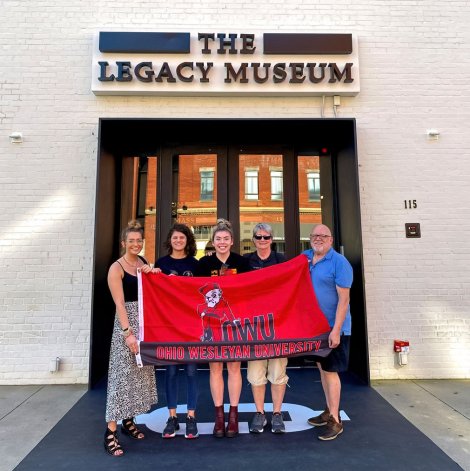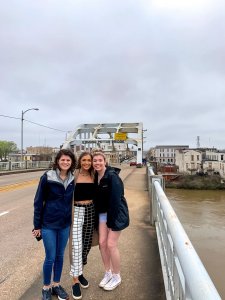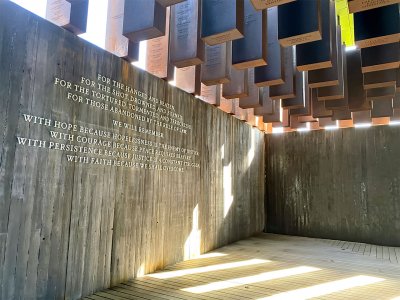
The March Continues
Ohio Wesleyan Student Reflects on OWU Connection Trip to Mississippi, Alabama
Name: Mallorie Watts ’22
Hometown: Delaware, Ohio
Majors: Social Justice and Politics and Government
OWU Connection Experience: “The March Continues: The Current Fight for Justice and Equality” Travel-Learning Course
Watts and students Megan Dalton ’20 and Paige Ross ’21 traveled to Mississippi and Alabama during spring break as part of an OWU Connection Travel-Learning Course (TLC). The course, and travel component, helped them to develop an awareness and understanding of “social justice” and “activism” and to explore equitable and inequitable educational practices.
Their trip followed 10 weeks in class and was led by faculty members Paula White, Ph.D., professor of education, and John Durst, associate professor of sociology and anthropology. The weeklong trip included visiting several sites along the National Civil Rights Trail, where many events of the Civil Rights era took place during the 1960s.
Their experience also involved a panel discussion put together by OWU alumnus Deak Rushton ’83, president of the Alabama-based James Rushton I Foundation, which works to provide high quality early childhood education programs and services to children up to 3 years of age.
Why I Chose This Experience
“I took this,” Watts says, “because I wanted to learn more about the Civil Rights movement and the stories told about it. I was interested to see and compare the different narratives and memories of the movement.”
My Favorite Moment
“I don’t know if I could pick one moment. I didn’t have an epiphany, I felt more of a grappling for the entire trip.
“One thing that really stood out to me is how people of the Civil Rights Movement did not have one form of activism. People were activists in different ways. I think highlighting this is vital because we tend to expect everyone’s activism to be what our own ideas of activism is.”

Walking the Edmund Pettus Bridge
“I would say one of the most powerful moments of the trip was in Selma when we walked the Edmund Pettus Bridge. I do not have the words to describe the feeling. When we got halfway over the bridge, when those who marched would’ve seen the mob waiting for them, I could not imagine what they would have been feeling. I have no way to grasp that. …
“We tend to talk about how brave these people were but when we do that, we tend to erase how gruesome it was. Or when we saw the motel room Martin Luther King Jr. stayed in before he died, it made me think about how does it feel to be doing something, knowing that you may be murdered at any time? How do you live like that?”
Exploring the Role of Women
“We also talked about the complications of this. That sometimes people can’t do what MLK Jr. was doing, that they can’t risk being killed. That a lot of what MLK Jr. did was because Coretta Scott King was able to stay home and take care of the kids. …
“[People] never talk about how vital the women who hosted the leaders, who fed them, etc., were to the movement. I think Ava Duvernay’s ‘Selma’ subtly captures this.”
Lessons Learned
“I think it was interesting to compare how the different museums presented Civil Rights history. I thought one thing, in particular, was the narrative of the role of music in the Civil Rights Movement.
“Most of the time, we only think about gospel music. This plays a big part, but some of it can sanitize the movement. There was little discussion about music from the late ’60s and ’70s. In one of the museums, there was a piece that talked about music and black pride. It only mentioned James Brown, but didn’t discuss Lorraine Hansberry or Nina Simone.
“I think something that was apparent was how messy social movements can be. That many times we think the Civil Rights movement was unified and on the same page, but that isn’t true.”
‘Linked Fate’
“One of the best things I saw was at the Memphis Civil Rights Museum; it told the story of the Montgomery Bus Boycott really well. It delineated how it was not just Rosa Parks deciding to say ‘no’ one day. But it was behind-the-scenes organizing and the idea of linked fate that made this successful. That for 382 days, the Women’s Political Council made this boycott possible, even though MLK Jr. was seen as the public leader for it.
“I think the Bus Boycott is more of a keyhole issue that captures that the movement was not combatting simple ideas of segregation, but how pervasive the oppression was. Whether it was what types of jobs people had access to, housing, transportation, policing of space, political power, etc.”

‘Horrors of Lynching’
“I realized how little many people know about the horrors of lynching in America. We went to the National Memorial for Peace and Justice, which was a powerful and emotional experience. You can tell how intentional everything was, and I could go on forever about it. But one thing I will share is how the EJI (Equal Justice Initiative) wanted this memorial to serve as a place to have the conversations about the history we choose to sweep under the rug, but you can't.”
Joining a Movement
“In one of our reflections, we were asked if we would join the Civil Rights Movement, that if we were alive and our age back then, would we join? I'd like to think that I would, but if I reflect honestly, I'd be lying if I said I would join. I don't think I would've because nothing in my life now tells me that I would've.
“I ask myself: Did I drop everything to fight against the injustices going on today, especially the controversial ones? I haven't.
“I haven't taken part in efforts against ICE (to the same scale as the Civil Rights Movement). I haven't taken action in solidarity with farmworkers. Flint STILL doesn't have clean water, and I've kept on with my life. I watch a video of a police officer beating someone, and what did I do? People are dying because we are choosing profits over people, and what did I do? I think we all would like to think we would've, but I don't think we are being honest.”
Individual Activism
“I don't think that everything has to look like the Civil Rights Movement. I don't think that everyone's activism looks the same, I don't think you should expect that. We all have different roles in the ecosystem for change and that these roles are ALL vital. That maybe someone is not directly involved in a movement, but their actions are still valuable.
“I think there are other complexities to getting involved. Anne Moody wrote about how her involvement in the movement risked the lives of her family. That white mobs would threaten and attack her family because they found out she was in another state doing this work. I don't think many of us are able to navigate that question. I don't think I could.
“Risking your own life is terrifying, but also risking the lives of those who didn't choose?”
Why I Chose Ohio Wesleyan
“The honest answer is that OWU was the cheapest option for me. However, I couldn’t imagine myself anywhere else. One of the greatest things about OWU is the faculty and staff. So much of what I do is because of the amazing support system I have here at OWU. I also love the opportunities that students have to travel. I had no interest in traveling until I was part of a TPG (Theory-to-Practice Grant) that went to Denmark. I think OWU tries to make travel accessible to students who otherwise would not be able to.”
What are your plans after graduation?
“I am grateful for any recommendations!”
